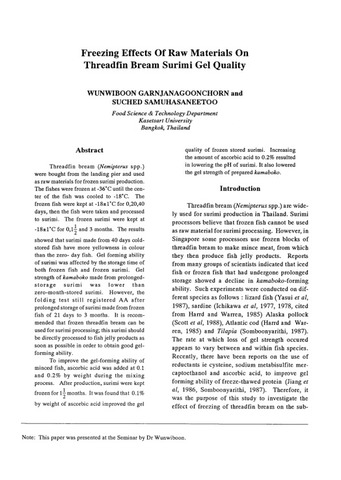| dc.contributor.author | Garnjanagoonchorn, Wunwiboon | |
| dc.contributor.author | Samuhasaneetoo, Suched | |
| dc.contributor.editor | Hooi, Kok Kuang | |
| dc.contributor.editor | Miwa, Katsutoshi | |
| dc.contributor.editor | Salim, Mohamed Bin | |
| dc.date.accessioned | 2019-04-25T10:28:10Z | |
| dc.date.available | 2019-04-25T10:28:10Z | |
| dc.date.issued | 1991 | |
| dc.identifier.citation | Garnjanagoonchorn, W., & Samuhasaneetoo, S. (1991). Freezing effects of raw materials on threadfin bream surimi gel quality. In K. K. Hooi, K. Miwa, & M. B. Salim (Eds.), Proceedings of the Seminar on Advances in Fishery Post-Harvest Technology in Southeast Asia: Singapore, 6-11 May, 1991 (pp. 170-175). Singapore: Marine Fisheries Research Department, Southeast Asian Fisheries Development Center. | en |
| dc.identifier.isbn | 9971882914 | |
| dc.identifier.uri | http://hdl.handle.net/20.500.12066/4792 | |
| dc.description.abstract | Threadfin bream (Nemipterus spp.) were bought from the landing pier and used as raw materials for frozen surimi production. The fishes were frozen at -36°C until the center of the fish was cooled to -18"C. The frozen fish were kept at -18±1°C for 0,20,40 days, then the fish were taken and processed to surimi. The frozen surimi were kept at -18±1°C for 0,1½ and 3 months. The results showed that surimi made from 40 days cold-stored fish have more yellowness in colour than the zero- day fish. Gel forming ability of surimi was affected by the storage time of both frozen fish and frozen surimi. Gel strength of kamaboko made from prolonged-storage surimi was lower than zero-month-stored surimi. However, the folding test still registered AA after prolonged storage of surimi made from frozen fish of 21 days to 3 months. It is recommended that frozen threadfin bream can be used for surimi processing; this surimi should be directly processed to fish jelly products as soon as possible in order to obtain good gel-forming ability.
To improve the gel-forming ability of minced fish, ascorbic acid was added at 0.1 and 0.2% by weight during the mixing process. After production, surimi were kept frozen for 1½ months. It was found that 0.1% by weight of ascorbic acid improved the gel quality of frozen stored surimi. Increasing the amount of ascorbic acid to 0.2% resulted in lowering the pH of surimi. It also lowered the gel strength of prepared kamaboko. | en |
| dc.language.iso | en | en |
| dc.publisher | Marine Fisheries Research Department, Southeast Asian Fisheries Development Center | en |
| dc.title | Freezing effects of raw materials on threadfin bream surimi gel quality | en |
| dc.type | Conference paper | en |
| dc.citation.spage | 170 | |
| dc.citation.epage | 175 | |
| dc.citation.conferenceTitle | Proceedings of the Seminar on Advances in Fishery Post-Harvest Technology in Southeast Asia: Singapore, 6-11 May, 1991 | en |

